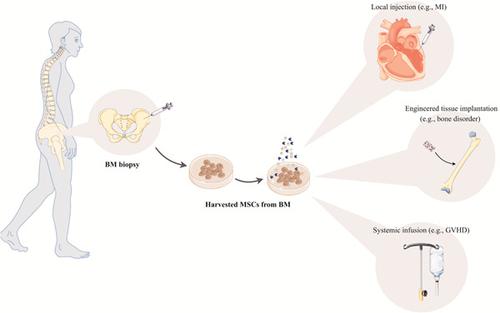当前位置:
X-MOL 学术
›
J. Cell. Physiol.
›
论文详情
Our official English website, www.x-mol.net, welcomes your
feedback! (Note: you will need to create a separate account there.)
Mesenchymal stromal cells; a new horizon in regenerative medicine.
Journal of Cellular Physiology ( IF 4.5 ) Pub Date : 2020-05-26 , DOI: 10.1002/jcp.29803 Shirin Tavakoli 1, 2 , Hamid Reza Ghaderi Jafarbeigloo 3 , Ali Shariati 2 , Afsaneh Jahangiryan 4 , Faezeh Jadidi 5 , Mohammd Amin Jadidi Kouhbanani 6 , Ali Hassanzadeh 2 , Majid Zamani 7 , Kamran Javidi 8 , Adel Naimi 9
Journal of Cellular Physiology ( IF 4.5 ) Pub Date : 2020-05-26 , DOI: 10.1002/jcp.29803 Shirin Tavakoli 1, 2 , Hamid Reza Ghaderi Jafarbeigloo 3 , Ali Shariati 2 , Afsaneh Jahangiryan 4 , Faezeh Jadidi 5 , Mohammd Amin Jadidi Kouhbanani 6 , Ali Hassanzadeh 2 , Majid Zamani 7 , Kamran Javidi 8 , Adel Naimi 9
Affiliation

|
In recent decades, mesenchymal stromal cells (MSCs) biomedical utilizing has attracted worldwide growing attention. After the first report of the human MSCs obtaining from the bone marrow (BM) tissue, these cells were isolated from wide types of the other tissues, ranging from adipose tissue to dental pulp. Their specific characteristics, comprising self‐renewality, multipotency, and availability accompanied by their immunomodulatory properties and little ethical concern denote their importance in the context of regenerative medicine. Considering preclinical studies, MSCs can modify immune reactions during tissue repair and restoration, providing suitable milieu for tissue recovery; on the other hand, they can be differentiated into comprehensive types of the body cells, such as osteoblast, chondrocyte, hepatocyte, cardiomyocyte, fibroblast, and neural cells. Though a large number of studies have investigated MSCs capacities in regenerative medicine in varied animal models, the oncogenic capability of unregulated MSCs differentiation must be more assessed to enable their application in the clinic. In the current review, we provide a brief overview of MSCs sources, isolation, and expansion as well as immunomodulatory activities. More important, we try to collect and discuss recent preclinical and clinical research and evaluate current challenges in the context of the MSC‐based cell therapy for regenerative medicine.
中文翻译:

间充质基质细胞;再生医学的新视野。
近几十年来,间充质基质细胞(MSCs)的生物医学利用已引起世界范围的关注。在人类MSC从骨髓(BM)组织获得的第一个报道之后,这些细胞是从多种其他组织中分离出来的,这些其他组织从脂肪组织到牙髓。它们的特殊特征包括自我更新,多能性和可利用性,以及它们的免疫调节特性和对伦理的关注,表明它们在再生医学中的重要性。考虑到临床前研究,MSC可以在组织修复和恢复过程中改变免疫反应,为组织恢复提供合适的环境。另一方面,它们可以分化为多种类型的身体细胞,例如成骨细胞,软骨细胞,肝细胞,心肌细胞,成纤维细胞,和神经细胞。尽管大量研究调查了不同动物模型中MSCs在再生医学中的能力,但必须进一步评估MSCs非调控分化的致癌能力,以使其能够在临床中应用。在当前的审查中,我们简要概述了MSC的来源,分离和扩增以及免疫调节活性。更重要的是,我们尝试收集和讨论最近的临床前和临床研究,并在基于MSC的再生医学细胞疗法的背景下评估当前的挑战。在当前的审查中,我们简要概述了MSC的来源,分离和扩增以及免疫调节活性。更重要的是,我们尝试收集和讨论最近的临床前和临床研究,并在基于MSC的再生医学细胞疗法的背景下评估当前的挑战。在当前的审查中,我们简要概述了MSC的来源,分离和扩增以及免疫调节活性。更重要的是,我们尝试收集和讨论最近的临床前和临床研究,并在基于MSC的再生医学细胞疗法的背景下评估当前的挑战。
更新日期:2020-05-26
中文翻译:

间充质基质细胞;再生医学的新视野。
近几十年来,间充质基质细胞(MSCs)的生物医学利用已引起世界范围的关注。在人类MSC从骨髓(BM)组织获得的第一个报道之后,这些细胞是从多种其他组织中分离出来的,这些其他组织从脂肪组织到牙髓。它们的特殊特征包括自我更新,多能性和可利用性,以及它们的免疫调节特性和对伦理的关注,表明它们在再生医学中的重要性。考虑到临床前研究,MSC可以在组织修复和恢复过程中改变免疫反应,为组织恢复提供合适的环境。另一方面,它们可以分化为多种类型的身体细胞,例如成骨细胞,软骨细胞,肝细胞,心肌细胞,成纤维细胞,和神经细胞。尽管大量研究调查了不同动物模型中MSCs在再生医学中的能力,但必须进一步评估MSCs非调控分化的致癌能力,以使其能够在临床中应用。在当前的审查中,我们简要概述了MSC的来源,分离和扩增以及免疫调节活性。更重要的是,我们尝试收集和讨论最近的临床前和临床研究,并在基于MSC的再生医学细胞疗法的背景下评估当前的挑战。在当前的审查中,我们简要概述了MSC的来源,分离和扩增以及免疫调节活性。更重要的是,我们尝试收集和讨论最近的临床前和临床研究,并在基于MSC的再生医学细胞疗法的背景下评估当前的挑战。在当前的审查中,我们简要概述了MSC的来源,分离和扩增以及免疫调节活性。更重要的是,我们尝试收集和讨论最近的临床前和临床研究,并在基于MSC的再生医学细胞疗法的背景下评估当前的挑战。











































 京公网安备 11010802027423号
京公网安备 11010802027423号